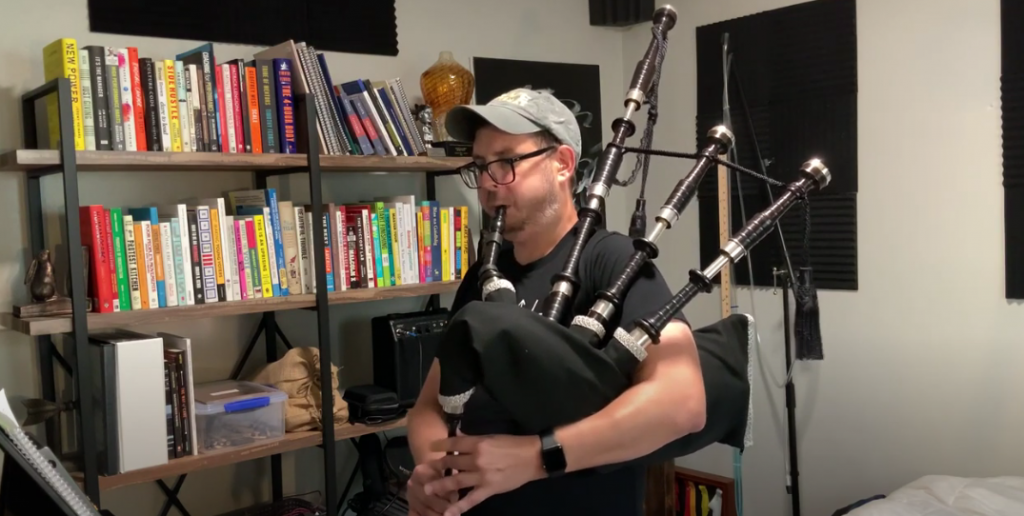Let's Get Ready to Get Performance Ready!

In case you hadn't heard, July 2023 is our next "themed month" here at Dojo U!
From July 7th to August 4th, we're on a mission to help you always show up ready and confident to perform.
When most of us first picked up our instrument, we had a goal in mind that involved performing - whether that was to play in a parade, play Amazing Grace at a graveside, compete with a local band, or anything in between. But as anyone who's ever had to play a solo can tell you... even if you've developed all the technical skills you need to competently play a bagpipe or drum, taking that next step to performing in front of an audience is another skill entirely!
During our intensive "Get Performance Ready" themed month, we're going to unlock your performance potential, with expert guidance as we overcome nerves, prepare you to tackle the unexpected, and develop the fundamental tools and techniques you need to consistently and confidently perform in front of others.
Before we kick off for the month, let's get a few essentials organized to set us up for success...
1. Hearing protection
Without hearing protection, you will damage your hearing as a piper or drummer, because our instruments are loud. You can use any kind of hearing protection, from expensive scientific protection all the way down to simple foam ear plugs. As long as you have a way to plug those suckers up, you’re good to go!
2. Essential maintenance items
Many pipers have maintenance items in abundance in their case or practice room. Which is great! But at a bare minimum, here’s what you should have in your case at all times:
- A sharp blade like an exacto knife or box cutters.
- At least two rolls of yellow and/or black pre-waxed hemp.
- Small rubber corks (x3) for your drone-tops.
- Larger rubber corks (x5) for your stocks.
- Seasoning (only required if you play with a hide bag).
- Chanter-tuning tape (recommended, but not absolutely necessary).
- A digital hygrometer or two to keep track of temperature and humidity (recommended, but not absolutely necessary – don't worry, they're quite inexpensive).
3. A distraction-free space
One of the biggest killers of learning is distraction. Distractions are everywhere and constant, almost to the point where we’ve forgotten to notice that they are distractions.
The first thing you should do if you want to improve your piping is to set up a space with absolutely no distractions.
Here are some tips:
- Turn your phone on airplane mode (with wifi turned off) whenever you are in your practice room. This way, you can use your metronome and/or your camera, but you won’t get any notifications.
- If you don’t have a dedicated room, put some masking tape on the floor. Mark off a ‘safe’ space / distraction-free zone. When you cross that threshold, you are in sacred space!
- Set up your space so all your gear, devices, and instruments are set up and ready to go, always. Nothing derails faster than not having what you need when you need it.
- Put a sign on the door when you’re practicing to let your family (kids and spouse) know not to bother you when you are practicing.
- Feed your pets and make sure they are fully taken care of before each practice session.
- Feed yourself before each practice session!
- Fill your water bottle before practice.
- Find a way to climate-control your space consistently, each and every day. If you have to wait a half an hour for things to heat up or cool down, you’ll never get around to focused practice.
- Don’t share your space with anyone. If at all possible, make sure no one else uses your space at all. This is your functional practice zone, and when others go in there, they are going to mess it up. Then, you can never have the peace of mind to know your practice space is ready for you whenever you need it.
Take some time (yes, actually take some time) to think about practical ways you can transform your practice space into a true distraction free zone. If you want to be successful during the month (and for future practice sessions in general, anyway), you’re going to need to have your space 100% honed and ready to go.
Important advice: Two short practice sessions are way better than one long practice session. Shoot for short, fully focused, distraction-free practice sessions instead of long marathon sessions. In these short periods, you can truly stay distraction-free and truly leverage that focus for great results.
4. A recording device (highly recommended)
A recorder is an extremely vital tool for every piper to have and to use. We need to be able to play ourselves back, in high quality, in order to be able to analyze what we did after the fact.
Why do we want to do this? Well, because while we’re playing, we're (hopefully) 100% focused on playing! True analysis can only happen after the fact.
In a general practice session, you only need a smartphone or voice recorder. But it’s worth investing in a good recorder. If you’re ready to buy one, here are some important considerations:
- Your recorder needs to be on a separate device than your metronome (because we will need to use both at once often throughout our program).
- Your recorder needs to be able to adjust its input level (an adjustable gain) to avoid nasty distortion. Most recorders are only designed for voice recording, so when you try to record bagpipes or drums with them, they sound terrible.
- Your recorder should always be ready to go in your practice room – it should be ultra convenient to use it at a moment’s notice.
Read our up to date recommendations about which recorder to buy here.
5. A ‘solid’ internet connection
Once your physical practice space is set up, you’ve bought or built a manometer, the rest of your materials and tools are on our website.
Thus, in order to be successful working with us at Dojo U, your internet connection will need to be 'decent.' Our definition of 'decent' is:
- A bare minimum of 5MB/second download speed.
- At least 1MB/second upload speed.
How do you tell how fast your internet is? Simple – just type “test my internet speed” into Google and use any of the free tools that pop up to measure it.
6. And last, but definitely not least – your instrument:
For some of us, this could be the first moment where we need to swallow our pride and make a significant adjustment to things in order to make progress.
For bagpipers, this means that to be successful, you'll need to set your pipes up comfortably, so you should adopt a ‘simple’ bagpipe setup, at least for the duration of the topics we're going to cover during our themed month.
Here's what you should have in a simple set-up:
- A set of pipes made by a reputable maker (Hint: if you bought these for less than $500 (USD), they're probably not legitimate pipes!)
- An adjustable blowstick (preferable so we can size and fit your instrument correctly during the process of learning correct posture)
- A pipe chanter by a reputable maker, manufactured within the last five years
- A few ‘beginner strength’ or proper strength chanter reeds (to determine your reed strength, do the ‘Scotland The Brave’ test)
- Simply designed synthetic drone reeds (eg Ezee Drone, Kinnaird, Canning, Selbie, etc.)
- A good quality bag (hide or synthetic – make sure you have seasoning on hand if you're playing hide)
- Small zip ties for your drone cords
Here's what you should NOT have in a simple set up:
- A water trap (unless you experience extreme moisture)
- 'Tone enhancer' valves (or other copycat products that attempt to do the same thing)
- Canisters, hoses, or ANYTHING that attaches to the bottom of our stocks inside the bag
- Any sort of desiccant tool or material inside the bag.
Also, please avoid:
- Complex drone reed designs and/or 'moisture absorbent' drone reeds
- Cane drone reeds (cane is amazing but not for the scope of this month).
Some 'gadgets' that are okay:
- Moose valves
- Tone Protector chanter caps (or copycats)
- Split blowpipe stocks (for eventual insertion of water trap)
Another thing to consider is that your instrument setup uses modern components. With the possible exception of your bagpipes themselves, your bag, chanter, drone reeds and chanter reeds should all have been manufactured in the last 10 years.
This basic rule of thumb ensures that you’re not unknowingly being held back by outdated components.
Some common examples of outdated equipment that can cause a learning deadlock:
- A piper is trying to use a chanter from 1990. This doesn’t work because the chanter designed much flatter than modern reeds are designed for (amongst other reasons).
- A piper is using Ezee Drone reeds from 1995. More often than not, super aged reeds tend to become unstable and less and less reliable over time. It’s time for an update!
- A piper is using an Elkskin bag from the 1950s (it came with the pipes!). It’s time for a new bag that holds air better and handles moisture better.






Responses